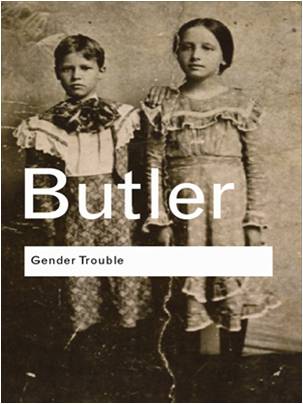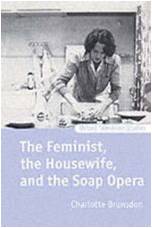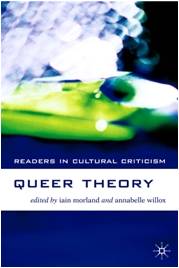On this page, I will examine gender and women’s studies and the main points of queer theory to understand how the three originally proposed stereotypes exist in telenovelas. Next, I will look primarily at the portrayal of women in television in the US and Latin America. I will then look at the relationship between the gay male and straight female.
GENDER AND WOMEN’S STUDIES
The next discipline I chose to look at is Gender/Women’s Studies. I believe that in order to understand the stereotypical triumvirate - La mujer vanidosa (The Vain Spanish Female); El hombre machista (The Macho Spanish Male); and El hombre homosexual (The Gay Spanish Male) – I must understand how the female and gay male functions in their societies. Therefore, I looked at the current scholarly debate surrounding gender theory.
I decided to first look at Judith Butler because her research on gender is very pertinent to the existence of the three stereotypes in the telenovelas. Butler defines gender as a “linguistic index of the political opposition between the sexes” (Butler 21). She states that the word ‘gender’ is singular because only the feminine gender exists naturally, “making masculinity a resistive response to femininity” (Butler 23). Therefore, the only reason why the masculine identity exists is because it is resisting feminine identity. So, men act masculine to attack the feminine identity. Next, Butler explores the concept of gender performativity and heteronormativity in her book, Gender Trouble: Feminism and the Subversion of Identity. These two concepts help one understand the complexities of gender and sex in male and females. Gender performativity explains that as babies we are born genderless. Instead over our lives, “we observe and are taught the way to act, we are educated on how to perform our genders” (Butler 132). This means that if you are born with the male sex, but are taught to perform with a feminine identity, then your gender is not male masculinity but male femininity.

After understanding basic gender theory, I needed to look at how women are portrayed in television. This brought me to Charlotte Brunsdon and again Chris Barker. I first choose to look at Feminist Charlotte Brunsdon’s piece, The Feminist, the Housewife, and the Soap Opera to see how women are portrayed in television from the point of view of a female feminist. Brunsdon’s definition of a soap opera is simple:
The entire soap opera can be fit into a single social and psychological category whose members could be regarded as different from everyone else and whose interest in soap operas is seen as deriving not from a genuinely aesthetic impulse but from a psychopathological need for role reinforcement (Brunsdon 43).
Brunsdon believes that soap operas are driven primarily off the psychology of male and female identity. She cites two media studies authors – Rudolf Arnheim and Michèle Mattelart – to defend her idea of soap operas as psychological mediums. Brunsdon states that because of its fictiveness and ability to take its audience and escape reality creates the attractiveness of soap operas.

I also read Chris Barker’s argument of soap operas and the representation of women within them. Barker purports an idea that soaps address personal issues which speak to women’s competencies, giving the female viewer pleasure. At the same time, Barker critiques the presentation of women in soaps: “the use of glamour and the physical appearance of women to enhance soaps is the subject to the criticism that the representation of women is for the male gaze” (Barker 83). Thus, soaps are a double-sided sword for women – even as they may be strong-minded in soaps, their strength is frequently put at the service of family and ultimately the men within it through their sexualized roles.
As Brunsdon and Barker speak primarily about women in television in the Anglo world, I decided to look at the history of Spanish women in television in Latin America. What I found is that women are just as strong, if not even more independent, in their roles. Writer Sueann Caulfield investigates female television roles in her article, The History of Gender in the Historiography of Latin America. Caulfield first states how one must critique gender in Latin America, as it is different than North American feminist thought:
The prevalence of dependency analysis, emphasis on class oppression, and early criticism of North American feminists meant that from the start, women were generally studied in the context of their class and region. Class and sex were frequently seen as independent variables that might be weighted differently in different settings: class inequalities could take precedence in industrialized nations (Caulfield 458).
Therefore, class ranks as the highest benefactor in determining the role and position of Spanish woman. And so, Caulfield investigates the economy of the Spanish female in television to determine her role. What she concludes is that women hold a special mobilized role in society as “marianismos.” The concept of marianismo is a result of “of traditional Iberian values transported to the Americas with colonization, Latin American women wield power by extending into the public sphere their roles as mothers and guardians of morality in the home” (Caulfield 461). Thus, Spanish women on television are presented in roles because of their class and position over the family economically. Just like the Anglo world, Spanish females are also subjugated to the demands of the male and still do not have the absolute financial autonomy as the male has.
QUEER THEORY, AND QUEER/STRAIGHT RELATIONSHIPS
For Queer Theory, I returned to Judith Butler and Iain Morland to grab the basics of the discourse. Queer Theorist Iain Morland first states that gay is a highly politicized term, denoting queer males solely. In his book, Queer Theory, Morland states that in order to under gay or lesbian, one must understand queer and how the identity of queer is a sexual pathology: “the acknowledgement of their [queers] individual truisms, gender, sex and sexuality which face reconstruction in the practices of many individuals and in the community’s view of who can claim membership” (Morland 121). Therefore, based on the components of gender, sex and individual truisms of a person is what defines him or her as queer.
Judith Butler’s concept of heteronormativity goes hand in hand with Morland’s definition of queer. In Gender Trouble, Butler outlines how heteronormativity defines what is socially normal and/or deviant. She states that there is a life spectrum that people follow by; it is dictated by your gender and sex. If you are a female, then you only have female friends. The only time you have contact with a male is when you are engaging in sexual acts. Heteronormativity states that if you are male sex, you are masculine and are only attracted to the female sex. Therefore, if your sex is male, yet you are attracted to the male sex, then you are not socially normal (Butler 141-146). Queer is where a person decides to practice an individual truism, sex or gender differently. Butler then states that the idea of being classified as different is problematic for people who identity as queer:
The disciplinary production of gender effects a false stabilization of gender in the interests of the heterosexual construction and regulation of sexuality within the reproductive domain. The construction of coherence conceals the gender discontinuities that run rampant within heterosexual, bisexual, and gay/lesbian contexts in which gender does not necessarily follow from sex, and desire, or sexuality generally does not seem to follow from gender (Butler 135).
After looking at the introduction into queer theory, I then moved to television and how queer is portrayed on television. I looked only at the portrayal of gay men in soap operas to understand the gay Spanish male. I looked at the journal of Feminism & Psychology to study gay male television roles in the cases investigated by Dan Sheppard.

In his work, Discourses of Friendship between Heterosexual Women and Gay Men, Sheppard studies the theory of human relations, and how they are based on an implicit model of heterosexuality. He studies the unique relationship gay males share with straight females. Sheppard states that the relationship is completely against social norms because 1) gay males are already deviant of the gender performativity spectrum, acting feminine, and 2) they are resisting the concept of heteronormativity by having close yet platonic relationships with women. Therefore, this televised relationship between the gay male and straight female contradicts social norms, yet makes the relationship even more unique.
GENDER/WOMEN/QUEER THEORY CONCLUSION
As we have read, gender/women’s studies and queer theory all have unique positions on how male and females exist. Through investigation of gender/women’s studies, we have been able to understand that gender is singularly feminine and that the masculine is the response to femininity (Butler). We then viewed how women are portrayed on television; women are used to address empowerment (Brunsdon and Barker); they are continually sexualized (Barker); whereas Spanish women have remained in the middle role – neither autonomous nor unimportant – based on their economic position (Caulfield). We have studied queer theory, understanding that queer is genderless and is a response to the spectrum of heteronormativity (Butler and Morland). Finally, we read how the televised relationship between gay males and straight females contradicts social norms yet strengthens the queer identity (Sheppard). I believe that by understanding these terms, one can understand the existence of the stereotypical triumvirate within telenovelas.
|